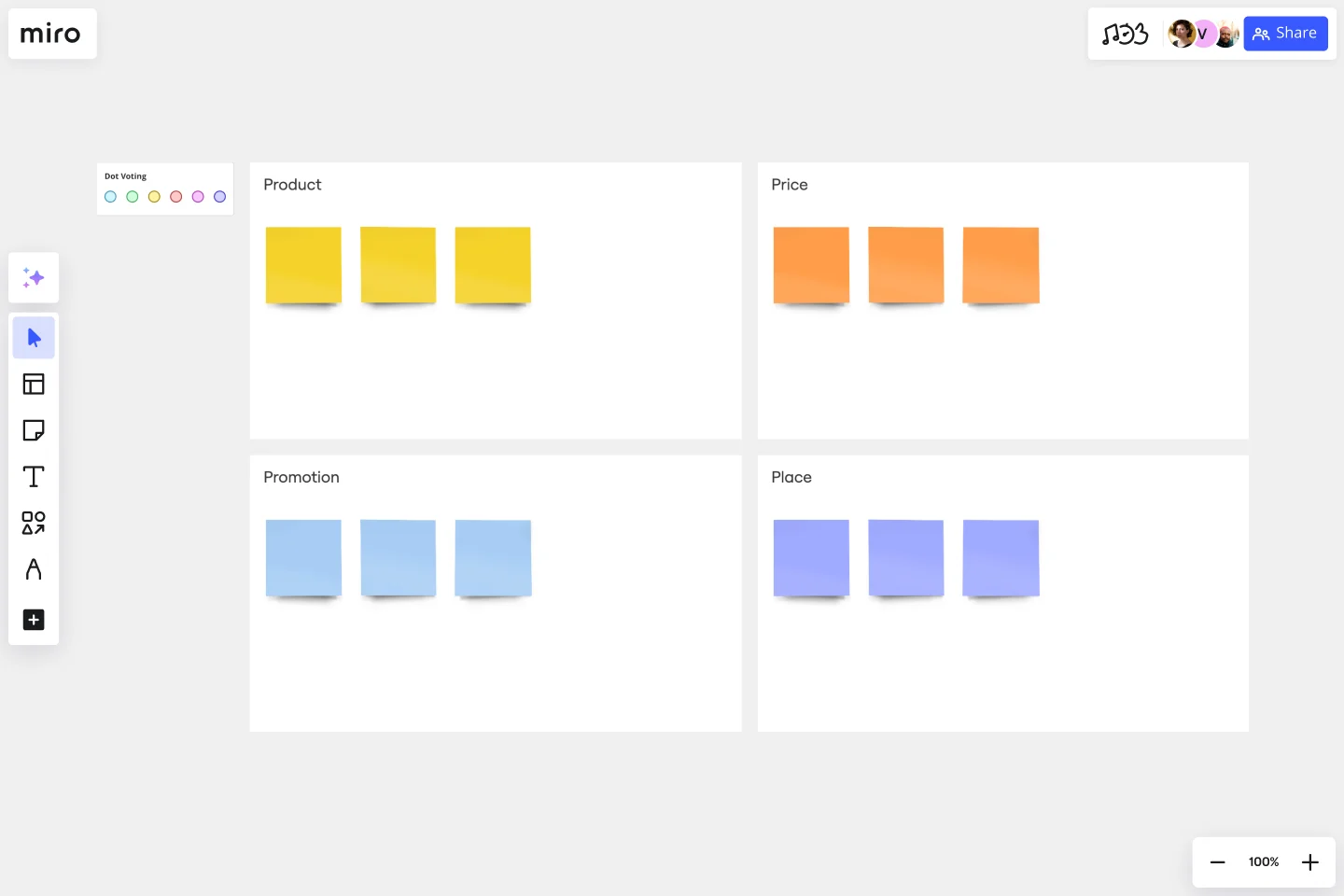4P Marketing Mix Template
Map a marketing mix that meets the needs of your target audience.
About the 4P Marketing Mix template
What is a 4P marketing mix?
A marketing mix comprises the elements an organization might use to execute a successful marketing plan. The term was coined in the late 1940s, and Harvard professor Neil Borden used it in his 1953 address to the American Marketing Association.
The 4P Marketing Mix Template allows you to map out four controllable factors affecting your company profits: product, place, promotion, and price. By deciding on the mix of these four factors, you can determine the ideal way to take a new product or service to market. Read on to find out more about how this template can help your team
What are the 4 Ps?
The 4 Ps stand for: Product, Place, Promotions, and Price. Let’s look at each one in more detail.
Product: is the tangible good or service that satisfies the target audience’s needs.
Place: refers to where and when the product is available.
Promotions: include advertising, digital marketing, PR, event marketing, direct marketing, personal selling, channel marketing, and alliances.
Price: consists of the policies regarding basic price, upgrades, discounts, coupons, distributor price, etc.
Benefits of marketing mixes
An effective marketing mix can help your business develop strengths and limit weaknesses, become more competitive, adapt to the market, and collaborate with partners. Specifically, a marketing mix can help your organization answer the following questions: Who is your customer? What problem do they have? What prevents them from solving it? How does your product or service solve that problem? How does your customer or potential customer feel about your competitors? How do they feel about your business? What motivates them to make a purchasing decision?
When to use a 4P marketing mix
Organizations can develop a marketing mix at any stage of growth. Once you’ve answered the questions above, you can begin to build your marketing strategy.
Create your own 4P marketing mix
Miro is the perfect tool to create and share your marketing mix. Here’s how to create yours using this template:
Step 1: Start by selecting this 4P Marketing Mix template.
Step 2: Choose a specific product or service to analyze.
Step 3: Go through each quadrant, adding relevant information in sticky notes or uploading other file types.
You may also want to color code your sticky notes so you can distinguish between positive and negative points. Once your team is satisfied with the result, you can easily share with other teams to get their feedback.
Discover more marketing plan template examples and supercharge your marketing efforts.
Get started with this template right now.
Assumption Grid Template
Works best for:
Leadership, Decision Making, Strategic Planning
Someone wise once said that nothing in life is certain. But the waters of the business world? It can seem especially uncertain and unclear. An Assumption Grid can help you navigate those waters and make your decisions confidently. It organizes your business ideas according to the certainty and risk of each — then your team can discuss them and make judgment calls, prioritize, mitigate risk, and overcome uncertainties. That’s why an Assumption Grid is a powerful tool for getting past the decision paralysis that every team occasionally faces.
Service Blueprint to connect journey & operations
Works best for:
Research & Design
Connect customer journeys with operational processes using the Service Blueprint by Essence. This template helps you map out service interactions and backend processes, ensuring seamless service delivery. Use it to align teams, identify gaps, and enhance the customer experience. Perfect for visualizing the entire service ecosystem and improving coordination between different service components.
Brainwriting Template
Works best for:
Education, Ideation, Brainstorming
Brainstorming is such a big part of ideation. But not everyone does their best work out loud and on the spot, yelling out thoughts and building on others’ ideas. Brainwriting is a brilliant solution for them—creative thinkers who happen to be more introverted. This approach and template invites participants to reflect quietly and write out their ideas, and then pass them to someone else who will read the idea and add to it. So you’ll get creative ideas from everyone—not just the loudest few.
Research Topic Brainstorm Template
Works best for:
Desk Research, Brainstorming, Ideation
Coming up with a topic for a research project can be a daunting task. Use the Research Topic Brainstorm template to take a general idea and transform it into something concrete. With the Research Topic Brainstorm template, you can compile a list of general ideas that interest you and then break them into component parts. You can then turn those parts into questions that might be the focus for a research project.
SOAR Analysis Template
Works best for:
Leadership, Decision Making, Strategic Planning
The SOAR Analysis template prompts you to consider your organization’s strengths and potential to create a shared vision of the future. The SOAR Analysis is unique in that it encourages you to focus on the positive rather than solely identifying areas for growth. SOAR stands for Strengths, Opportunities, Aspirations, and Results. To use the template, examine each category through a positive lens. Perform a SOAR Analysis whenever you want to bring people together and encourage action.
The 4-Step Retrospective
Works best for:
Retrospectives, Agile Methodology, Meetings
The 4-Step Retrospective template offers a simple yet effective framework for conducting retrospectives. It provides steps for reflecting on what went well, what didn't go well, what could be improved, and action planning. This template enables teams to systematically review past iterations, identify areas for growth, and implement actionable improvements. By promoting a structured approach to reflection and improvement, the 4-Step Retrospective empowers teams to drive continuous learning and enhancement effectively.
